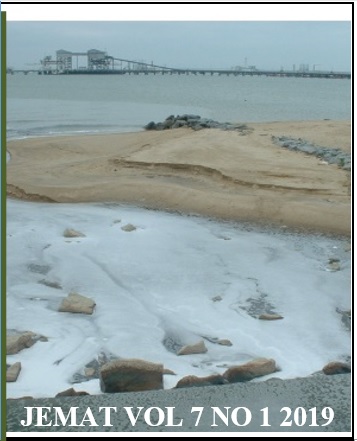Mathematical Relationship of Optical Density, Total Viable Count and Microbial Biomass for Growth of Serratia marcescens Strain AQ07 on Cyanide
DOI:
https://doi.org/10.54987/jemat.v7i1.465Keywords:
Mathematical Relationship; Optical Density; Serratia marcescens; BioremediationAbstract
This study illustrates the mathematical relationship between Optical Density (OD600nm), Total Viable Cell Count (CFU/mL) and Microbial Biomass (mg/dry weight) of Serratia marcescens strain AQ07. The parameters were tested using spectrophotometric, colony-forming unit per ml and oven drying methods respectively. Bacterial density range of 0.2, 0.4, 0.6, 0.8 and 1.0 were correlated with the other two growth analyzing methods to correspond with 4.37 x 1015, 1.02 x 1016, 1.61 x 1016, 2.19 x 1016 and 2.77 x 1016 CFU/ml and bacterial biomass corresponding to 1.01, 2.14, 3.29, 4.43 and 5.57 mg/ml respectively. This illustrates a clear relationship that can be explored in the batch growth remediation process so as to avert the continuous processes of viable cell count and microbial biomass techniques at every stage in the course of research. It saves cost, time and energy exhaustion as well help in simplifying research process since there is the need for researchers to report microbial parameter in mass (mg/ml) or Colony Forming Unit/mL rather than OD600nm. Moreover; this technique can be utilized in modelling the bioremediation batch technique.
Downloads
Published
How to Cite
Issue
Section
License
Authors who publish with this journal agree to the following terms:
- Authors retain copyright and grant the journal right of first publication with the work simultaneously licensed under a Creative Commons Attribution License (http://creativecommons.org/licenses/by/4.0) that allows others to share the work with an acknowledgement of the work's authorship and initial publication in this journal.
- Authors are able to enter into separate, additional contractual arrangements for the non-exclusive distribution of the journal's published version of the work (e.g., post it to an institutional repository or publish it in a book), with an acknowledgement of its initial publication in this journal.
- Authors are permitted and encouraged to post their work online (e.g., in institutional repositories or on their website) prior to and during the submission process, as it can lead to productive exchanges, as well as earlier and greater citation of published work (See The Effect of Open Access).


